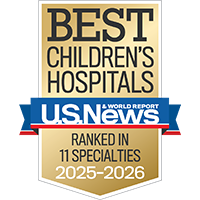Soothing the soul
Our music therapy program nurtures patients with bedside serenades, rap workshops and more.
Find out more

Tremors are a neurological disorder that causes involuntary shaking or trembling in one or more parts of the body. They're typically seen in the hands but can also affect the arms, legs, torso, head and vocal cords. Tremors may happen on their own or be caused by certain medical conditions, medications or other triggers.
At UCSF Benioff Children's Hospitals, our pediatric neurologists are highly trained in identifying the causes of tremors in children and determining the best treatment approach.

Ranked among the nation's best in 11 specialties

One of the nation's best for neurology & neurosurgery

in NIH funding among U.S. neurology programs
Many people with tremors have a condition called essential tremor. Essential tremor often runs in families and typically doesn’t cause additional symptoms.
Other causes include:
It's helpful to understand that everyone has tremors to some degree. In most people, tremors are barely noticeable, but certain factors – such as fatigue or too much caffeine – can make them more pronounced, even in people without a health issue.
Signs of tremors may include:
Tremors may be constant or come and go. If severe, they can make it hard to do everyday tasks, such as eating, getting dressed and writing.
Tremors in children should be evaluated. The doctor will ask about your child's symptoms and medical history as well as your family medical history. They may perform a neurological exam.
As part of the evaluation, the doctor will assess:
Your child's doctor may order tests, such as:
The following are some of the more common tremor types.
The most common type of tremor is called essential tremor (also known as benign essential tremor or familial tremor). It usually causes a tremor in both hands and arms while the person is moving them, but it can also impact the legs, voice or head. People with essential tremor don't have other neurological symptoms.
Although essential tremor typically appears during adolescence or middle age, it can start at any age. In up to 70% of cases, essential tremor is an inherited condition. If inherited, it may show up earlier in life. The tremor may remain mild or slowly worsen over time.
This type causes big, slow tremors in the arms, legs, hands or feet that become worse at the end of purposeful movements, such as reaching for an object. It’s caused by damage to the cerebellum (a part of the brain located in the back of the head) and its pathways.
This type causes involuntary muscle contractions, usually in the vocal cords, neck, or arms and legs.
Mild tremors may not need treatment. If your child’s tremors are caused by a medical condition or medication, treating the underlying condition or stopping the medication may reduce or eliminate the tremors.
There is no cure for most types of tremor, but treatment can help control symptoms. Options include:
The doctor may also suggest lifestyle modifications, such as:
This information is for educational purposes only and is not intended to replace the advice of your child's doctor or other health care provider. We encourage you to discuss any questions or concerns you may have with your child's provider.
Soothing the soul
